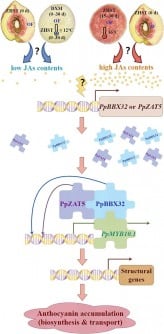Recent research has uncovered the genetic and hormonal mechanisms that dictate color variation in peaches. A collaborative study by scientists from Zhejiang University and the New Zealand Institute for Plant & Food Research identifies two key genes, PpBBX32 and PpZAT5, which regulate the expression of PpMYB10.1. Published on July 30, 2024, in the journal Horticulture Research, this study sheds light on how these genes respond to environmental factors and internal hormones, influencing the development of red hues in peaches.
Anthocyanins, the pigments responsible for vibrant red, purple, and blue colors in various fruits, play a critical role not only in aesthetic appeal but also in health benefits due to their antioxidant properties. In peaches, the levels of anthocyanins vary significantly across different cultivars, tissues, and storage conditions. Notably, moderate cold storage has been shown to prompt red coloring in the outer flesh of certain peach varieties, while others remain unaffected.
Despite the understanding of downstream genes involved in anthocyanin synthesis, the upstream regulatory mechanisms influenced by environmental factors and hormones have remained elusive. This gap in knowledge necessitated a deeper investigation into the transcriptional networks that govern pigment accumulation, leading to this recent study.
The researchers utilized transcriptomic comparisons across various peach cultivars and storage conditions to observe that anthocyanin accumulation in the outer flesh of the ‘Zhonghuashoutao’ variety was temperature-dependent, occurring specifically at 16°C. The identification of PpBBX32 and PpZAT5 as central regulators was based on their strong expression correlation with anthocyanin levels. Functional assays demonstrated that overexpression of either gene significantly increased pigment levels in both peach and tobacco. Conversely, silencing these genes resulted in reduced anthocyanin accumulation.
Both proteins were found to directly bind to the promoter of PpMYB10.1, activating its transcription. They also form a ternary protein complex—PpZAT5–PpBBX32–PpMYB10.1—which amplifies the activation of pigment-producing genes. Moreover, the expression of these genes was inducible by methyl jasmonate, aligning with endogenous jasmonate levels that correlated with anthocyanin content across different tissues and temperatures.
“This study gives us a molecular explanation for something growers and consumers have observed for years—why some peaches develop beautiful red flesh while others don’t,” stated Dr. Changjie Xu, the corresponding author of the study. The identification of these genes not only enhances the understanding of fruit pigmentation but also provides breeders with valuable targets for improving both the appearance and health benefits of peaches.
The implications of this research extend beyond peaches. The insights gained into the PpBBX32–PpZAT5–PpMYB10.1 regulatory module present opportunities for enhancing fruit coloration in other crops where color is a key quality trait. Breeding programs could leverage this knowledge to develop cultivars with more consistent and vibrant red flesh, regardless of environmental conditions.
Furthermore, postharvest strategies could be implemented using jasmonate analogs or optimized storage temperatures to activate these natural genetic pathways, thereby boosting anthocyanin levels in harvested fruit. This research not only enriches the field of horticultural science but also contributes to the broader goal of enhancing food quality across various crops.
The funding for this research was provided by the National Natural Science Foundation of China, the Pao Yu-Kong International Fund, and the 111 project (B17039). The findings mark a significant advancement in understanding fruit pigmentation processes, setting the stage for future innovations in agricultural practices.





































































